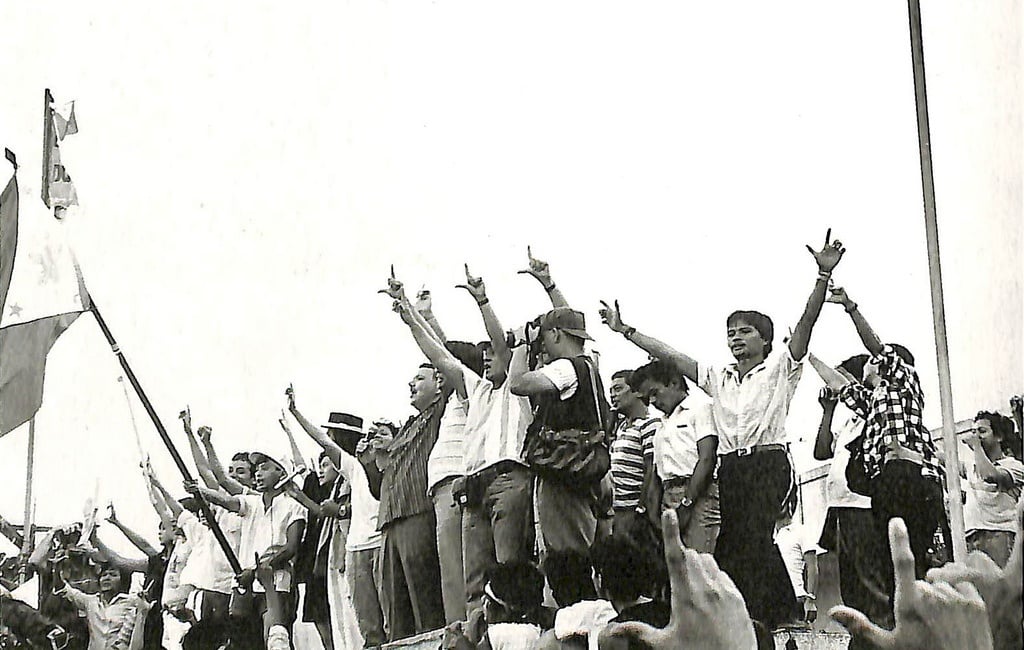Herstory: Corazon C. Aquino, A Leadership Of Love And Democracy
 Contributed by
Michaela Anchan
February 7, 2016
Contributed by
Michaela Anchan
February 7, 2016

As the first female president of the Republic of the Philippines, Corazon Aquino – or Cory, as she is fondly called – is best known for leading the Filipino people into the 1986 People Power Revolution and eventually restoring democracy in the country.
Born the sixth of eight children on January 25, 1933, in the province of Tarlac, Maria Corazon Sumulong Cojuangco hailed from a wealthy family of Chinese, Spanish and Filipino descent that was known in both the banking and political spheres of that time.
The young Cory was said to be very shy, studious and a devout faithful of the Catholic Church. She lived in Manila until the age of thirteen when she moved to the United States, eventually earning her bachelor’s degrees in French and Mathematics from the New York-based College of Mount St. Vincent in 1953. She returned to Manila and had started a law degree when she met Benigno “Ninoy” Aquino Jr, who, like Cory, hailed from a family that was considerably wealthy. The ambitious journalist caught her eye, and Cory abandoned her law school plans to instead get married.
Ninoy’s career path switched from being a journalist to being a politician and, within the span of two decades, he rose up the ranks of politics until he eventually became a senator. Throughout these times, Cory remained staunchly supportive of her husband’s political career but preferred to stay out of the limelight. In the background, she was raising their large family of five children and raising funds for her husband’s campaign, which made things very financially tight for them.
Ninoy frequently challenged the dictatorship of then president Ferdinand Marcos, and was eventually imprisoned for eight years by Marcos. In 1980, he was permitted to go to the US for medical treatment on an agreement to never return. During this time abroad, Cory stepped into the limelight more, passing on Ninoy’s messages to the media for the people.
In 1983, on the day he arrived back in the Philippines, he was assassinated.
Ninoy’s assassination was the last straw for the Filipino people, who had been suffering in a deteriorating country under the rule of the Marcos regime. With a government neck-deep in debt and the desire for a candidate to finally depose Marcos, Cory assumed her husband’s place as opposition leader and ran in a snap election, which Marcos himself had initiated. At first, Cory showed reluctance in running, but with the support of one million signatures that was the evidence of the Filipino people’s trust in her, she agreed to run against Marcos for the presidency.
The election period saw Marcos resorting to degrading remarks to ridicule Cory’s campaign, using sexist statements to put her down. But, while Marcos stated that Cory was “just a woman” and had a place in the bedroom and not in politics, Cory simply answered with: “May the better woman win in this election.” Not only was her gender attacked but her lack of political experience was also scoffed at. To this, the young widow responded with honesty: that, unlike Marcos, she admittedly had no experience in lying to the people, cheating, stealing money and having political opponents assassinated.
The snap elections of February 1986 declared Marcos as the winner, and the entire country was outraged at the fraud. As she never believed in violence being the solution, Cory still called for peaceful civil disobedience protests and mass boycotts, as well as organized strikes against the media and various businesses owned by the Marcos family.

Through these acts of peaceful and effective demonstrations, the Filipino people all the more supported Cory and eventually gathered together for the People Power Revolution. This peaceful demonstration was comprised of thousands of people from all walks of life and religious orders. Despite sending out tanks and armed troops, no one was harmed and many of the troops eventually came to side with the peaceful demonstrators. By the end of the month, Marcos fled to Hawaii and Cory was installed as the first female president of the Philippines on February 25, 1986. This same year, Cory also became TIME magazine’s choice for Woman of the Year.
At the onset, Cory’s presidency was all about helping the country recover from the trials borne out of the Marcos dictatorship years. She had a new constitution drafted and created the Presidential Commission on Good Governance (PCGG), a unit assigned to go after the ill-gotten wealth accumulated by the Marcos family. Her presidency had a strong emphasis on human rights and civil liberties; she and her cabinet had numerous peace talks with a number of Muslim secessionists and communist insurgents. The economy also experienced a bit of breathing space as the Aquino government was able to pay off US$4 billion worth of debts. Her time as president was not an easy one, with so many things to repair and numerous Marcos supporters that made coup attempts on her governance, but she remained faithful to her promise of serving the Filipino people.
When her term came to end in 1992, there was much clamor for the popular president to run for a re-election. However, Cory strongly declined all requests for her to extend her term. She was a true model when she opted to show her capability to be both a good president and citizen, unlike Marcos who wanted to remain in power indefinitely. She graciously and willingly stepped down and made way for her successor, Fidel Ramos, who also happened to be her defense secretary during her administration. But despite the end of her term and return to normal citizen life, she still remained vocal and opinionated about important political issues that came to rise after her term.
In 2009, Corazon Cojuangco Aquino passed away due to colon cancer. Her passing drew global attention, and thousands were present at her wake and funeral. Global figures had their share of acclaims for Cory, including Hillary Clinton and Pope Benedict XVI giving their own words about Cory’s bravery, steadfast commitment to freedom, strong rejection of violence and overall love for her countrymen and women.
Cory served with sincerity, and a love for the Filipino people. Her journey from being a homemaker to becoming an advocate of democracy and respected politician represents an extraordinary metamorphosis, and she remains a powerful icon in the Philippines, Asia and around the world as a leader who brought forth momentous and radical change in this world.
Visit Woolf Works page to find out more about the Coworking space.
Written by: Arlene Lagman
Arlene Lagman is the administration assistant of Woolf Works. She loves inspiring stories about natural beauty, self confidence, personal development, woman empowerment and happy endings. As a food enthusiast, traveler and writer, she always tries to find time for new experiences and adventures. |
This post was first published on Woolf Works blog and has been reposted on Executive Lifestyle with the permission of the author.
Edited by Nedda Chaplin
Image Credit:
Corazon Aquino inauguration from the Malacañang Palace archives
Artists and performers stage a show outside the station to celebrate- Photo by Erwin Elloso, People Power: The Philippine Revolution of 1986 by Presidential Museum and Library PH
Did you enjoy this post? Please comment, like and share!
Lifestyle Featured












Sorry, the comment form is closed at this time.